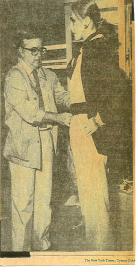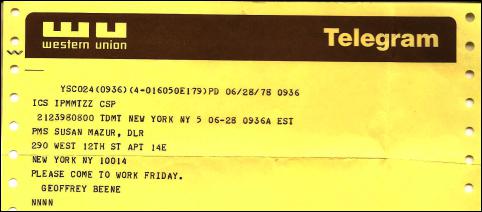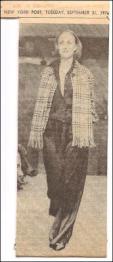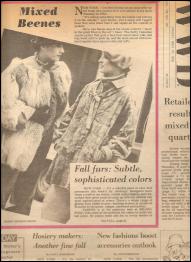Suzan Mazur: Geoffrey Beene, Spacewear & DARPA $$$
Geoffrey Beene, Spacewear & DARPA $$$
By SUZAN MAZUR


Geoffrey Beene, and Geoffrey Beene with Suzan Mazur, New York Times 1978"
"I
gave up medicine. So I'll give up fashion. . . I could be a
colorist of spaceships." -- Geoffrey
Beene
With DARPA (Defense Advanced Research Projects Agency) now offering $500,000 in seed money for ideas related to sending humans into space, which it will award this November, I thought I'd revisit my Omni magazine conversations on future fashion with designers I modeled for in the 1970s. Between 1976 and 1978, I probably modeled the most for Geoffrey Beene.

Beene liked simplicity and unrestricted comfort in clothing -- sometimes throwing his own shoes (size 12) into the collection, which he expected the models to finesse.. He was dubbed "Dean of American Designers," and was commercially very successful.



Click images to enlarge
Suzan Mazur modeling Beene (l to r): New York Post '76; Women's Wear Daily '78; WWD '78
In 1998, Geoffrey Beene was presented with the lifetime achievement award by New York's Council of Fashion Designers. He died in 2004 and requested that all future net profits from the sale of Geoffrey Beene products be donated to philanthropic causes.
He was somewhat of an enigma in life, a minimalist who revealed little personally about himself, his playful eyes the giveaway.
There was a certain theatricality backstage as well as onstage at Geoffrey Beene. An Old South theatricality. Beene liked being addressed as "Mr. Beene." He had a maid on staff, a black maid who spoke rapidly in a high pitched voice. She wore a uniform -- complete with hat and apron -- and would serve him daily fixes of lemon water.
Although the model's room at Beene was spacious with a powerfully lit room-length mirror, there was a lot of unannounced traffic through it -- buyers, an occasional actress looking for a party dress, Polly Mellen of Vogue with two hands cupped like a telescope previewing a garment for a shoot. And the maid frequently en route to and from the design room. . .
Beene would also drop in without notice to visit the accessories drawers, pause, and with a breathy Louisiana accent connect by making a brief pronouncement: "Red is lovely on you." (Red was Beene's women's fragrance.) Or to admonish: "Do you have a suntan?" and "You're looking too demure. Nothing is perfect."
Privately I was told I reminded Beene of his former Icelandic model -- a good thing. I was also advised that he was livid the day I popped an oversized balloon prop onstage during a fur show, which was unscripted. I later learned the balloon cost $250.
We know he was from a Louisiana family of doctors and he did bring his mother into the model's dressing room one day, but did not formally introduce her. At least I don't remember shaking her hand, although I do recall the substantial diamond rings she wore and that she resembled Geoffrey Beene in stature.
Michael Coady who ran the fashion industry's bible in the 1970s, Women's Wear Daily, once told me over lunch in the garden of Barbetta's restaurant, that Geoffrey Beene's real name was Sammy Bowsman, Jr. Beene had an ongoing feud with Fairchild, publisher of WWD and W, about its advertising rates and so I never really attempted to verify Coady's statement.
Beene's approach to men's wear, his scrapping of the angular lapel for a roundish collar and introduction of smock-like roominess to jackets, challenged the system to the extent that he was refused entry to lunch at Windows on the World restaurant atop the World Trade Center wearing one of his creations. Ironically, Beene's name was all over television at the time in American Express credit card commercials. Being the Southern gentleman he was, he left the restaurant amused and without argument and settled for lunch at Geoffrey Beene -- served by the maid.
Our interview follows (Feb.
'79):
Suzan Mazur:
What kind of spacesuit do you think you could come up
with?
Geoffrey Beene: I said a couple of years ago the most quickly antiquated piece of clothing would be the spacesuit. Because the first one looked like something from out of early Frankenstein. When I see it now, I begin to realize it even more. But the spacesuit was a giant step forward for civilization, and I think the mere fact that it worked is extraordinary. It had to be reduced and probably will get even sleeker.
Suzan Mazur: They tell me at NASA the suit was constantly leaking and they had to keep filling it with oxygen. . . NASA is now designing what they call the blue collar spacesuit for people of average conditioning to go up into space to make space colonies. They think this will happen within 50 years.
Geoffrey Beene: Are they doing anything about thermally-controlled clothing?
Suzan Mazur: The military is working on that
Geoffrey Beene: I think that's going to be the next major step here on Earth. The next revolution in fashion will come from the chemist's tube. The light at the end of the tunnel seems to be stretch fabrics. That's the only incentive for me really as far as something new going into the 80s that can lead to more space-type clothing, and uniforms, predicted so many years ago. I do think fabrication that can react to temperature is just wonderful and should come about. It would stop this Hot - Cold dressing.
Suzan Mazur: This is Nomex on the outside, which is highly heat resistant. It's unaffected by up to 800 megarads of radiation. The problem is, it's very stiff.
Geoffrey Beene: They'll find a way. It'll become a stretch somehow. . .
Suzan Mazur: I think designers and manufacturers have to ask for these fibers.
Geoffrey Beene: Well, I'm beginning to. As a matter of fact, I had Frank Parker of DuPont telephone me that he read where I thought stretch was the light at the beginning of the tunnel for the 80s. And I now have stretch fabrics that are tweeds, velvets and others outside those commonly used in sportswear. . . I have on a pair of corduroy pants at the moment that stretch. I've had them for four years and they've been pressed twice. That was just because I thought they should be. It wasn't necessary.
What lies in the chemist's tube can change our whole mode of dressing and will come in a short time. DuPont did ask me would I show them the things I was doing with stretch fabrics. Perhaps they'll get into it deeper. So there already is a great interest by the big companies.
Suzan Mazur: I know Betsey Johnson has been clamoring at DuPont's door and apparently DuPont's been giving her a hard time.
Geoffrey Beene: They will. She's right. She's very imaginative. She's perfectly right. And I don't know why it's so difficult to pound down doors if we're so innovative. And cannot be with natural fibers. We certainly can be with synthethic or a mixture of the two. Betsey's certainly on the right track. Hers is a little wild in point of view, but she's on the right track.
Suzan Mazur: One NASA engineer in research and development of life support systems for space has commented that his wife would hate for him to design a dress for her. Do you think the growing desire for functional clothing will, in fact, bring about a necessary marriage of the fashion designer and engineer? And do away with the fantasy element in dress? Will today's ready-to-wear designers lose importance in the culture as did the couturier?
Geoffrey Beene: Well a designer's whole premise is to dress the society, to dress a person whose needs are imposed by a society. So indeed whatever the needs are in the future, a designer must serve them.
I don't say it would be less fancy. It may be decorative in a different way. But the premise of all good fashion or style is that something be comfortable or functional. So I do not think it would lessen the so-called couturier -- which I hate the name of anyway. I call myself a conceptual designer, not a fashion designer. . .
Suzan Mazur: But do you think there's going to be a marriage with engineers?
Geoffrey Beene: There will have to be. It presents another challenge, which is the fun of being a designer.
Suzan Mazur: Clothing is now being designed for the quasi-physical part it plays in relation to the human system. As a second skin, so to speak.
Geoffrey Beene: That's not new. That has always been true. It's true not only of clothing. It's true of cosmetics. It's true of perfume. That's why I'm deeply involved in those things. All second skin.
Suzan Mazur: But don't you think there was not as much of a conscious effort before concerning clothing as second skin? People are beginning to think about it more as part of the human system.
Geoffrey Beene: Well, with the health movement and quickening pace of living. That's probably what's bringing it about as much as anything else. We're moving as such a pace!
Suzan Mazur: In an environmentally inhospitable future here on Earth, where for instance, the ozone shield has deteriorated up to 20% and perhaps beyond what a 1976 National Academy of Sciences report predicted could happen within 50 years and resulting increased levels of radiation now threaten us with possible muscle atrophy, skin, lung and other cancers, hair loss and sterilization if we do not wear protective clothing. Or where the air we breathe becomes so smog-laden due to relaxed smog standards and transnational air pollution that it becomes dangerous to not only breathe, but unsafe even for skin contact for any prolonged period. In such an environment where clothing would be essential for life support, what kind of second skin do you envision?
Geoffrey Beene: With all the horrendous implications you've made about what could happen, I just hope our government and scientists will be a bit more precautious. What you're telling me -- it's a very unhealthy state, isn't it.
It goes back again to needs. If that happens, there's a need for something. So one must find it. At this point, I cannot predict what that is. Given enough time, I'm sure chemists can. I personally don't have a great knowledge of chemistry. As a matter of fact, I failed it at the university. I much preferred foreign languages.
Suzan Mazur: Gerard O'Neill has been thinking about it. Do you know him? The physicist from Princeton and authority on space colonies who got his students together and asked them to think about space. So many interesting ideas were generated that he presented them to NASA, which is taking them seriously. O'Neill says space colonization is possible within the next 25 years.
Geoffrey Beene: Incredible.
Suzan Mazur: One of the women in O'Neill's group has decided on not having a child until she's in space.
Geoffrey Beene: She'd better get a lot of pills.
Suzan Mazur: In such an environment that O'Neill is talking about, solar energy will be continually available and in its regulation the colony will thrive agriculturally. This is a picture of the colony, inside one of the tubes.
Geoffrey Beene: Just incredible. It really is.
Suzan Mazur: The colony would be totally exposed to sunlight and the problem would be protecting it from radiation The first people going up there could create a kind of shield and after that sunlight could be regulated for various uses. The main occupation would be mining of asteroids and the moon for materials for use in the colonies, in space and on Earth.
Geoffrey Beene: Solar energy here on Earth that would be a good beginning. Let's get it going here first. There's a desperate need for it.
Suzan Mazur: Gravity in the colonies would resemble ours on Earth. But there would be areas of near gravity or zero gravity -- amusements centers, like for ballet. Honeymoon hotels, etc. . . . Clothing would not be a problem because temperatures would be ideally created.
Geoffrey Beene: I'd better look for another career. I gave up medicine. I'll now give up fashion. I'll become a colorist. I'll just color fashion. Color it in. Because colors affect people always. . .
Suzan Mazur: With a sophistication of the mobile society resutling from military research and development -- will the civilian interest toward adventure -- campers, backpackers, smaller apartments, mobile home living cause clothes as houses to be considered? Is it conceivable that humans will be able to travel much like a snail with a completely transportable personal environment in the near future?
Geoffrey Beene: With a shelter you mean?
Suzan Mazur: Yes.
Geoffrey Beene: Very likely. It goes back to thermal control again. Clothing reacting to environment.
Suzan Mazur: There's a group called Archigram and this is their conception of a cushicle or suitaloon. This is where someone could actually rest. This whole thing inflates. Bubbles. This is a view outside the storage area. And it can fold down into a suitcase. It can fold out into an automobile They call it the complete nomadic unit.
Geoffrey Beene: Amazing.
Suzan Mazur: It's very interesting to see what these nomadic units would do in the city. We wouldn't have the Pan Am Building there all the time or the Empire State Building. Structures would constantly be changing shape.
Geoffrey Beene: Well I love the Pan Am Building and Grand Central, so I don't wish to replace those. . .
Suzan Mazur: Since the energy impact resulting on an energy dependency on the Middle East may well be felt into the next century -- do you see a more prohibitive, less differentiated mode of dress influencing global fashion?
Geoffrey Beene: Oh indeed. I think what's happening in the Mid East should teach all the great civilizations lessons and make us much more resourceful. I think Western civilization, in particular, was at a point of taking itself for granted. Not being resourceful enough and depending so much on oil. All that will happen for a good reason. It's already making people think more. Be more resourceful.
Suzan Mazur: You think clothing will become more uniform, less differentiated.
Geoffrey Beene: There's going to be more uniformity. There'll be less selectivity.
Suzan Mazur: Suppose fertility is threatened, what kind of clothes might be created to encourage mating?
Geoffrey Beene: That's a typical question of Mr. Guccione. . .
Suzan Mazur: No that's my question. This is a sketch I made [I gave it to late Saturday Night Live comic Michael O'Donoghue, who decorated his Christmas tree with it one year]. This woman represents those people who remain on Earth after the environment gets terribly bad. They have to wear protective contraptions. Fertility is threatened but still has a chance.
Muscularity is weakened. This woman is wearing a device resembling a panier on which she can rest her arms. Century Panier Hoop Frames
The structure flashes, triggered by chemical reactions in her body when she sees someone attractive. . .
Geoffrey Beene: The body is still very sexually attractive to me without any ornament whatsoever.
Suzan Mazur: This is in the desperate future When the reproductive powers of humans have been virtually destroyed by radiation. So women wear this contraption. Or men wear wear it
Geoffrey Beene: You mean having something else other than the human body for attraction?
Suzan Mazur: Needing gadgets to support the vital things we used to be able to do naturally.
Geoffrey Beene: Within the body?
Suzan Mazur: Women wear this contraption. Or men.
Geoffrey Beene: Well I think both.
Both women and men will have to wear contraptions. It takes
two to tango. You have a sketch for the woman but you don't
for the man.
I don't know what the material would be. I
think it would be less complicated, less designed, something
much simpler. What I see in the future is more
simplistic.
Suzan Mazur: Scientists are talking about Earth as a reserve for adventure in the future. Colonies will be where people live and the Earth will be like going to the woods for recreation is today
Geoffrey Beene: I hope that remains true. I hope Earth always is synonymous with pleasure.
Suzan Mazur: What sort of costumes would you design for a ballet in a space colony on a one-tenth gravity stage?
Geoffrey Beene: A lot of iron bangles, embroidered with iron sequins. Iron ankle bracelets.
Suzan Mazur: A little bit more control.
Geoffrey Beene: Well the whole audience might be doing the same thing. So how could you tell the spectators from the performers?
Suzan Mazur: The audience is in a different location where there is more gravity.
Geoffrey Beene: It would be like slow motion Ballet, just slower. Probably more beautiful.
Suzan Mazur: What color?
Geoffrey Beene: Platinum. Metallic color. Metallic gauzes.
Suzan Mazur: That would be beautiful. NASA reports that within 50 years private enterprise will take over space operations. We can expect company Lear jets to be replaced with ships of another design. With fashion designers now taking part in automotive design, do you expect to be involved in the design of spaceships?
Geoffrey Beene: If I am asked and the need is there for me to be involved in the design of spaceships. I have found that I can design anything once I know what is needed. Certainly the external, visual parts. I can't even work a televison set, but I would love to design television sets. At the moment they're the ugliest thing in our society.
Suzan Mazur: What will happen to the industrial designers if fashion designers move into that role?
Geoffrey Beene: Designers could improve on the visual aspect. Fashion people have taste. Bring taste, simplicity, coloration -- that's what fashion is. You can take the slightest thing, change its color and it turns into something else. By that I mean, I've seen very "earthy' -- I've seen a sailor's middy dyed purple and [transformed]. It looked absolutely wonderful. If a spaceship is one color and suddenly another -- there's a great difference. I keep bringing color back into it because I think maybe in all this space talk, people are forgetting that color does influence us very much. And probably always will.
So, I could be a colorist of spaceships.
 Suzan Mazur
is the author of The
Altenberg 16: An Exposé of the Evolution
Industry. Her reports have appeared in the
Financial Times, The Economist, Forbes,
Newsday, Philadelphia Inquirer,
Archaeology, Connoisseur, Omni and
others, as well as on PBS, CBC and MBC. She has been a
guest on McLaughlin, Charlie Rose, and various
Fox Television News programs. For some years along the way,
she was a runway fashion model for Giorgio Sant' Angelo,
Geoffrey Beene, Bill Blass and other legendary designers.
Email: sznmzr@aol.com
Suzan Mazur
is the author of The
Altenberg 16: An Exposé of the Evolution
Industry. Her reports have appeared in the
Financial Times, The Economist, Forbes,
Newsday, Philadelphia Inquirer,
Archaeology, Connoisseur, Omni and
others, as well as on PBS, CBC and MBC. She has been a
guest on McLaughlin, Charlie Rose, and various
Fox Television News programs. For some years along the way,
she was a runway fashion model for Giorgio Sant' Angelo,
Geoffrey Beene, Bill Blass and other legendary designers.
Email: sznmzr@aol.com


 Martin LeFevre - Meditations: Animal Encounters During Meditative States
Martin LeFevre - Meditations: Animal Encounters During Meditative States Ian Powell: Gisborne Hospital Senior Doctors Strike Highlights Important Health System Issues
Ian Powell: Gisborne Hospital Senior Doctors Strike Highlights Important Health System Issues Keith Rankin: Who, Neither Politician Nor Monarch, Executed 100,000 Civilians In A Single Night?
Keith Rankin: Who, Neither Politician Nor Monarch, Executed 100,000 Civilians In A Single Night? Eugene Doyle: Writing In The Time Of Genocide
Eugene Doyle: Writing In The Time Of Genocide Gordon Campbell: On Wealth Taxes And Capital Flight
Gordon Campbell: On Wealth Taxes And Capital Flight Ian Powell: Why New Zealand Should Recognise Palestine
Ian Powell: Why New Zealand Should Recognise Palestine